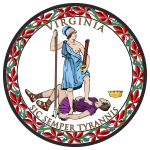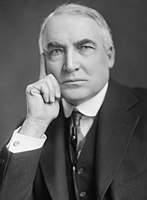| ||||||||||||||||||||||||||
| ||||||||||||||||||||||||||
 County Results
| ||||||||||||||||||||||||||
| ||||||||||||||||||||||||||
| Elections in Virginia |
|---|
 |
The 1920 United States presidential election in Virginia took place on November 2, 1920. Voters chose twelve representatives, or electors to the Electoral College, who voted for president and vice president. This was also the first presidential election after the passage of the Nineteenth Amendment, which granted women the right to vote throughout the United States, including Virginia.
The 1900s decade had seen Virginia, like all former Confederate States, almost completely disenfranchise its black and poor white populations through the use of a cumulative poll tax and literacy tests.[1] So severe was the disenfranchising effect of the new 1902 Constitution that the electorate for the 1904 presidential election was halved compared to that of previous elections, and it has been calculated that a third of those who voted were state employees and officeholders.[1]
This limited electorate meant Virginian politics was controlled by political machines based in Southside Virginia — firstly one led by Thomas Staples Martin and after he died the Byrd Organization. Progressive “antiorganization” factions were rendered impotent by the inability of almost all of their potential electorate to vote.[2] Unlike the Deep South, historical fusion with the “Readjuster” Democrats,[3] defection of substantial proportions of the Northeast-aligned white electorate of the Shenandoah Valley and Southwest Virginia over free silver,[4] and an early move towards a “lily white” Jim Crow party[3] meant that in general elections the Republicans retained around one-third of the small statewide electorate,[5] with the majority of GOP support located in the western part of the state. However, in many parts of the state — like in Tennessee during the same period — the parties avoided competition by an agreed division over local offices.[2]
Unlike North Carolina, Tennessee or Oklahoma — the other Southern states with the rudiments of a two-party system like typically contested statewide general elections — Virginia was influenced neither by Appalachian or Ozark isolationism[6] nor the Nineteenth Amendment. Virginia had not given women suffrage at any level before 1920, and in February the State House of Delegates rejected the Nineteenth Amendment by 62 to 22[7] and the state's Senate rejected it by a vote of 24 to 10.[8] There were efforts to have women's suffrage subject to a referendum and an amendment to the state constitution after it was rejected by the legislature,[9] but the idea was never carried out.
Neither Republican nominee, Ohio Senator Warren G. Harding nor Democratic nominee, former Ohio Governor James M. Cox campaigned in the state. Unlike Oklahoma, Tennessee and to a much lesser extent North Carolina,[10] there never was a thought that Virginia would be vulnerable to an expected and observed Republican landslide that saw Harding win the national election with 60.32 percent of the vote. Cox would win Virginia by a margin of 23.47 percentage points — a decrease vis-à-vis Woodrow Wilson's results in the two previous elections, but much less than the Democratic Party experienced nationally.
- ^ a b Kousser, J. Morgan (1974). The Shaping of Southern Politics: Suffrage Restriction and the Establishment of the One-Party South, 1880-1910. Yale University Press. pp. 178–181. ISBN 0-300-01696-4.
- ^ a b Key, Valdimer Orlando (1949). Southern Politics in State and Nation. pp. 20–25.
- ^ a b Heersink, Boris; Jenkins, Jeffrey A. (March 19, 2020). Republican Party Politics and the American South, 1865-1968. Cambridge University Press. pp. 217–221. ISBN 978-1107158436.
- ^ Moger, Allen. "The Rift in Virginia Democracy in 1896". The Journal of Southern History. 4 (3): 295–317. doi:10.2307/2191291. JSTOR 2191291.
- ^ Phillips, Kevin P.; The Emerging Republican Majority, pp. 210, 242 ISBN 978-0-691-16324-6
- ^ See Ruotsila, Markku (2003). "Conservative American Protestantism in the League of Nations controversy". Church History. 72 (3): 593–616. doi:10.1017/S000964070010037X.
- ^ "House Beats Suffrage by 62 to 22 Vote". The Portsmouth Star. Portsmouth, Virginia. February 12, 1920. p. 1.
- ^ "The Suffrage Amendment". Lenoir News-Topic. Lenoir, North Carolina. February 12, 1920. p. 2.
- ^ "The Suffrage Amendment". The Bristol Herald-Courier. Bristol, Tennessee. February 12, 1920. p. 4.
- ^ "Diverse Claims as to Tennessee: Memphis Says Cox Is Carrying State – Knoxville Reports Harding Ahead". The New York Times. New York City. November 3, 1920. p. 2.

